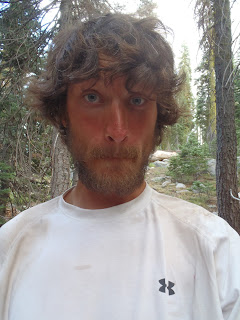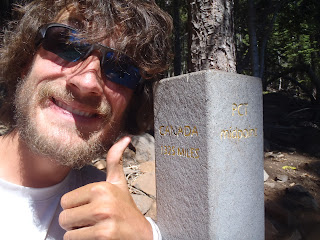A New Perspective
I think one of the most amazing things about reaching Oregon is how it has shifting my outlook on where I am on this trek. As I’ve mentioned before, hikers rarely look at the whole trail but the California/Oregon border is clearly one of those times. I found it was so relieving to finally be done pushing to finish the last bit of Northern California and suddenly be starting fresh at the bottom of a new state. In a way, I almost had that same sense of excitement and anticipation I had back at the Mexican Border.
I also am starting to recognize how far I’ve come. Before in California, I never really felt like I was on the northern part of the PCT and felt closer to the Mexican Border than even after the halfway point. Just recently when I got to Crater Lake, I sat back for a moment staring into the lake at sunset thinking, “Wow, I really can’t believe I’ve just walked all the way from Mexico up to here. Now I feel like I’m in the north and am even starting to eye Canada. It is so strange how I can count off my remaining resupplies, and the Washington border is less than 2 weeks away. I am loving every minute out here and can’t wait to make the most of this final month out in the woods.
Hello and Goodbye South-Bounders
One of the other neat things about reaching Oregon is this is the point where a lot of the north-bounders and south-bounders cross paths. SInce Washington is covered in snow until July, most south-bounders do not start until then which is why hikers don’t meet each other around the halfway point, a good 500 miles from here. This year was especially bad snow in Washington that stuck around, so very few south-bounders were able to make it all the way from the Canadian border and had to skip sections or flip-flop. It’s neat when you do get to talk to the south-bounders and get to hear about the trail ahead but so many times the encounters are brief as passing by on the trail. One of my favorite encounters was when I was hiking along and met this woman heading south. We chatted very briefly, and as I was leaving, I said what I am so accustomed to saying on the trail, “Well, see you later up the trail,” and she shot back with a quick, “well, see you never.”
I have gotten to hear a bit more from south-bounders in town or when I’ve stopped at awesome trail magic homes I’ve gotten so far in Oregon. South-bounding can be tough because there are probably only 20-25 thru-hikers who attempt it, and they cane be spread out. I saw my first south-bounder, Snake, 30, in Castella by Castle Craigs and just ran into a guy here in Shelter Cove 400 miles later. They talk about rarely hiking or camping with anyone and getting used to being alone on the trail, which is very different from the trail community north-bounders have. It’s also funny I find how I’ve asked them for tips on the trail when what I will actually see will be very different from what they’ve experienced. Where they saw snow, hopefully I will not have any, and the spots where the mosquitos might have been the worst will hopefully be dried out by the time I arrive. However, it is very motivating to hear about how amazing the North Cascades are and the best places in town to stop when resupplying. South-bounding certainly leads to a different way to experiencing the PCT, and I wish them all the best of luck as they blaze on by.
30s Galore
One of the biggest differences in Oregon is that I’ve been hearing since the start of the trail is that the trail grade is nice and flat with a few rocks in Oregon. Everyone would always say that Oregon is the best place to make up lost miles if running a bit behind schedule as it’s easy to do 30 miles day after day. I didn’t necessarily buy all of these rumors but have been shocked at how true they really are. Once I got into Oregon, big climbs became only 1,000 feet instead of 4,000 feet and everything has been so gradual, I could hardly tell I was climbing. One south-bounder has warned me not to do the climb out of Ashland in the afternoon sun which I ended up doing and about 5 miles in, I look over to my buddy Mad Dog and ask if we are actually climbing. He responded “Yes, I think we’re at the top.” However, while the days are so easy, I’ve found myself getting so lazy and enjoying sleeping in and swimming in all the lakes around here. Plus, I’m kind of stuck to a schedule to meet up with my friends, so there really isn’t much need for me to blaze ahead which allows me to sit back and enjoy the ride through this beautiful state.
Fire Season
I think one of the worst parts about Oregon is all of the fires. I was so excited back in California to have slipped by the fire that was right after Belden, and I narrowly snuck by the fire outside of Sierra Valley, but here in oregon, I have 3 reroutes to watch out for. I’ve already been through one by Windigo Pass which added an extra 4 miles to the trail and took me down into some of the buggiest areas yet in Oregon. In these reroutes, the forest service likes to send me down dirt roads which I hate, so afterwards, I’ve tried to find a parallel trail, or better yet, just bushwack through some of the sections which shaved a couple of miles off from this last detour. I am just about to enter my second reroute after I leave here in Shelter Cove, and this one is surprisingly similar in length to the actual PCT. There are also ways to stay on trails too. It’s the fire by Mount Jefferson I am the most worried about because there is potential the fires may shut down that wilderness area if the fire grows. I’ve already heard its a 20-mile reroute for 5 miles of trail. While I’m glad I don’t have to walk through the smoky blaze, I also know that a lot of these trail closures are for liability sake, and if I were to go through them, I may not find any smoke at all. However, the first service has put up a ton of red tape preventing me from passing through, and I even saw a ranger at one who wasn’t too happy with some hikers she saw on the closed trail earlier that day. In the end, I will take the reroutes but may end up free-styling it a bit finding better ways to get back to the PCT without entering the closed section to keep up my continuous set of footprints from Mexico to Canada.




























































